This post may contain affiliate links. Please read our disclosure policy.
Learn all of our tips and tricks to make the perfect New England Boiled Dinner. You’ll never have to worry about tough, over-cooked meat and mushy vegetables ever again!
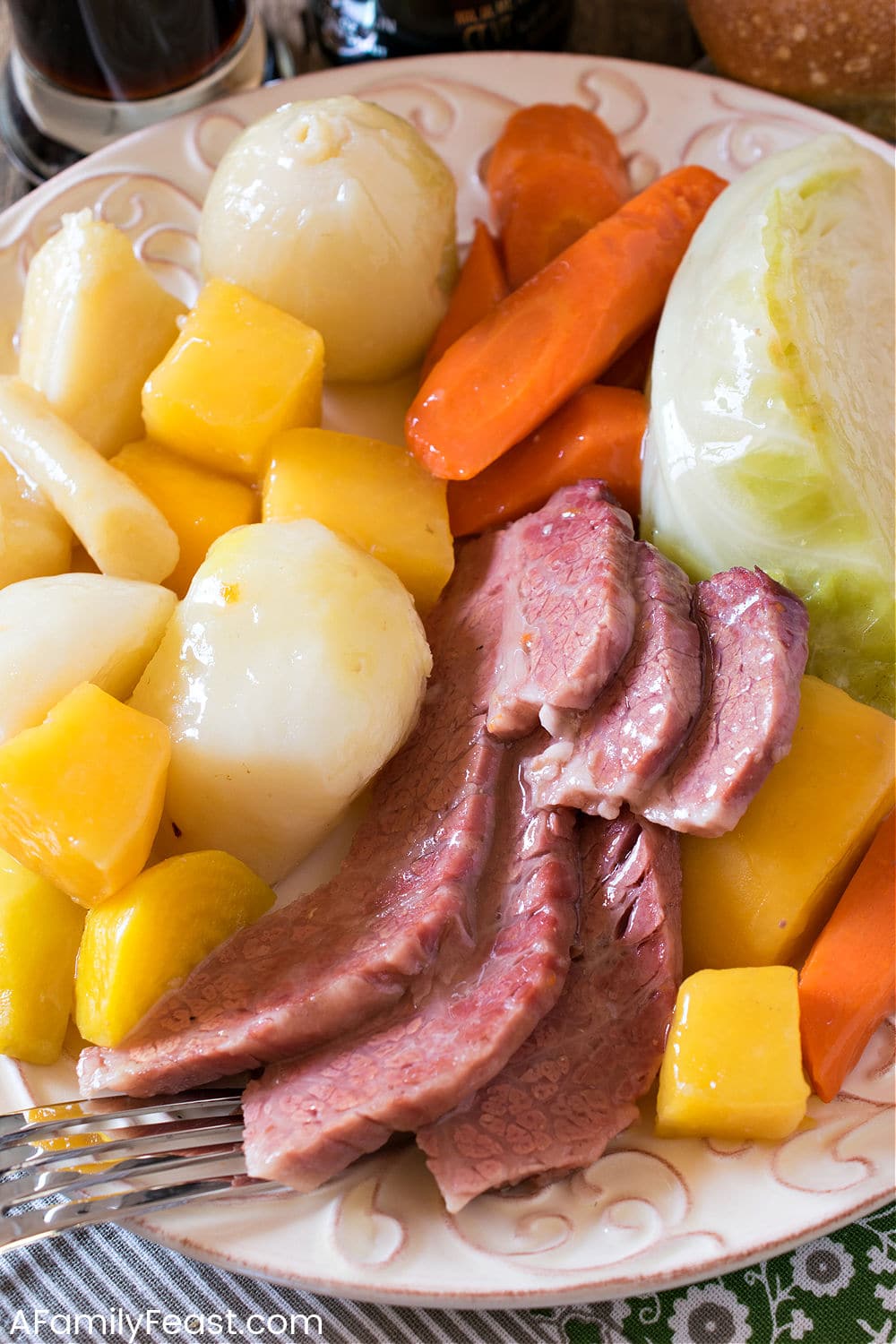
A New England Boiled Dinner is a classic Irish meal consisting of corned beef and cabbage, plus other boiled root vegetables like potatoes, carrots, onions, turnips, parsnips, and beets.
Sounds simple enough to prepare, but we’re sharing a few tips to help you achieve the most delicious, boiled dinner with tender, flavorful meat and perfectly-cooked vegetables.
Reader Review! “We had friends over for dinner and everyone commented that it was the absolute best boiled dinner they have ever had. My husband and I feel the exact same way. It was so delicious.”
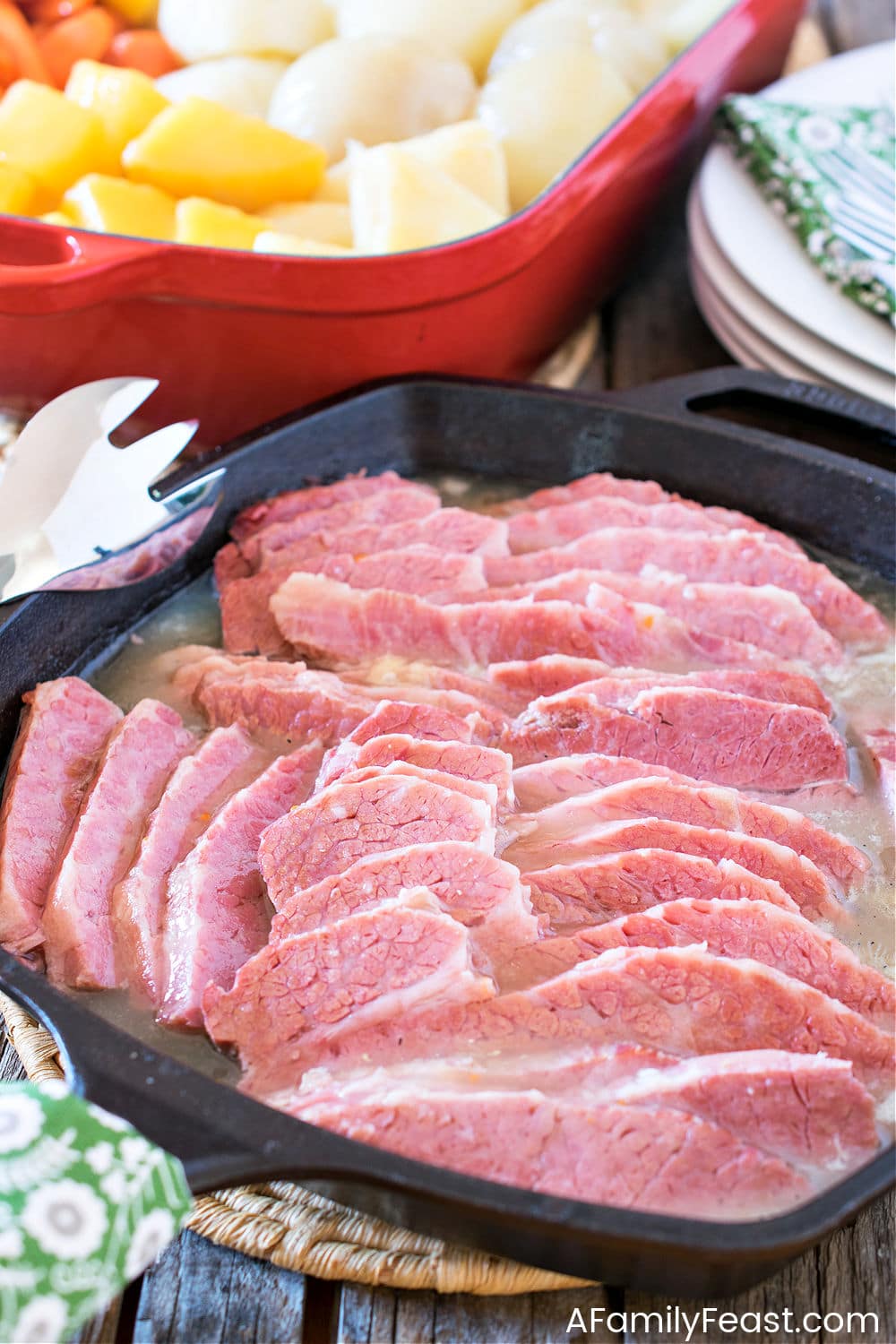
The trick to a perfectly-cooked New England Boiled Dinner
Years ago, when Jack made a boiled dinner in commercial kitchens, the crew typically prepared this dish by cooking each of the ingredients separately – NOT by throwing everything into one big pot to boil.
For our recipe today, Jack is applying that same concept for a home-cooked corned beef & cabbage dinner. When the meal is ready to be served, each vegetable is served on a large platter alongside the corned beef.
Jack also shares other tips and tricks that he learned throughout the years – including how to press the fat out of the corned beef meat after cooking, as well as thickening the broth to serve over the cooked meat and vegetables.
Fair warning – Jack’s write-up below is fairly-lengthy because he describes his cooking method in depth. But I think you’ll be thrilled with the results!
Why You’ll Love our Boiled Dinner recipe
- The flavors incorporated into the boiling liquid perfectly complement the corned beef and vegetables.
- Each component of the meal was cooked to perfection – not over or under cooked.
- You can make this dish ahead of time. In fact, for best results in terms of presentation, taste and texture, we recommend making this dish a day ahead and reheat just before serving. (We explain more below.)
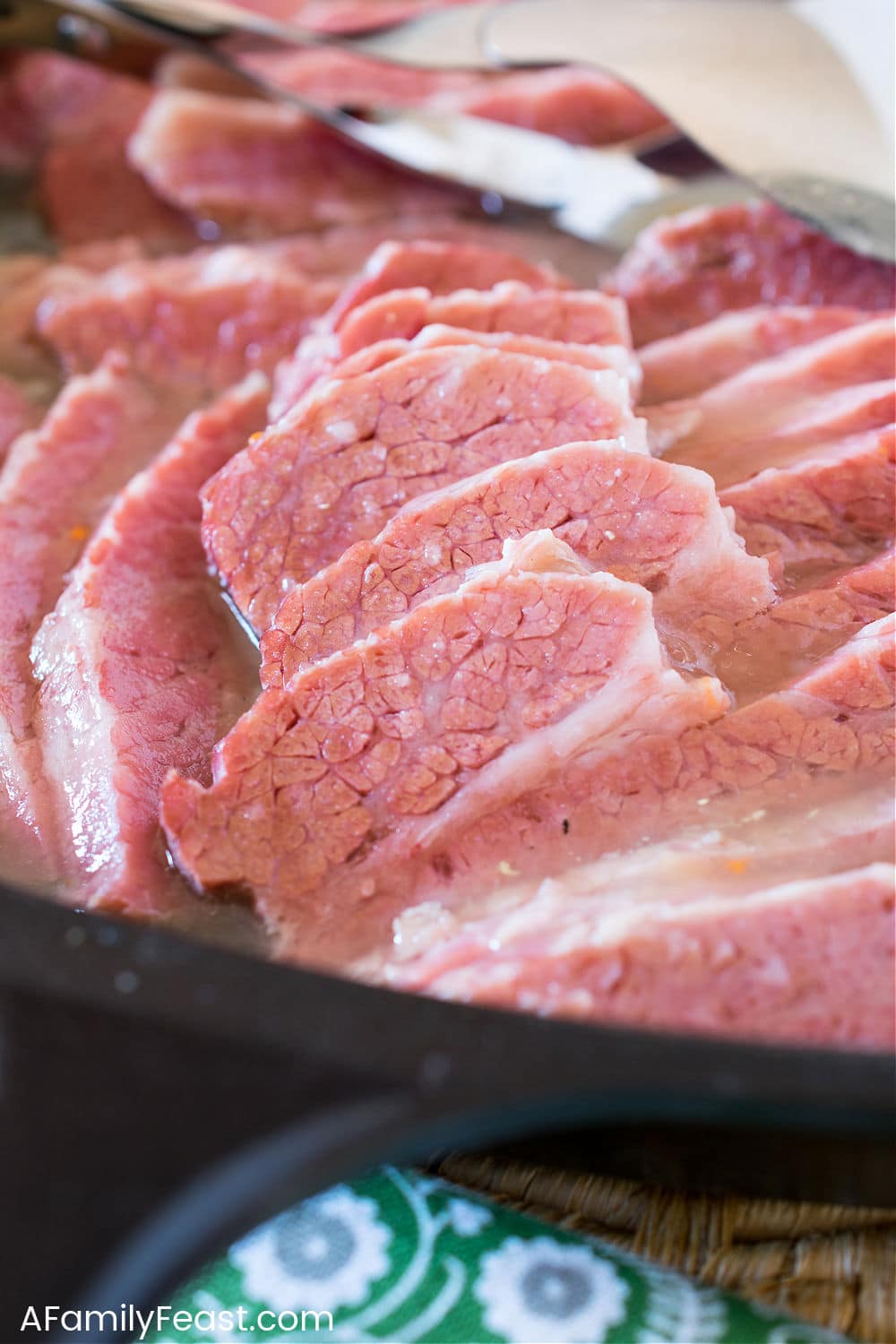
Key Ingredients and Substitutions
- Corned Beef – Corned Beef (grey or red) is traditional, but you can also make a boiled dinner with a fresh beef brisket, or a smoked pork shoulder*. For our recipe today, we’re focused on a red corned beef that has been brined with sulfates that turns the meat pink. When selecting your corned beef at the supermarket, keep in mind that you will lose some of the overall volume in trimming and cooking the beef. Our 4 ½ pound raw corned beef yielded 1 ½ pounds of usable meat so a full three pounds cooked off or was cut off in the form of fat. Make sure you plan accordingly and buy extra if feeding a crowd or want leftovers.
- Cabbage – Common green cabbage is the typical choice for a New England Boiled Dinner and we don’t recommend using other varieties for this recipe.
- Root Vegetables – You can make this easy dinner with any variety of root vegetables but we do recommend at least some potatoes (we used new red potatoes), carrots and onions. Other options include yellow or white turnip, parsnips, and yellow beets.
- Spices – For the cooking liquid, you’ll use a mix of spices including whole black peppercorns and cloves, bay leaves, whole mustard seeds, coriander seeds, allspice berries, fresh ginger, a cinnamon stick, and a pinch of red pepper flakes. Alternately, you can use a store-bought pickling mix instead.
- Corn Starch – A bit of corn starch is added as a thickener to the cooking liquid – this creates a thicker sauce for serving over the corned beef and vegetables.
Chef’s Tip – To avoid serving over-cooked vegetables, we take the time to cook each variety separately – then combine them together in the end for serving. (We think the results are worth this extra step.) Having said that – if you don’t have time for this, we do give you the option of cooking the vegetables in one pot (see recipe card below) – first adding the vegetables to the pot that take the longest to cook, then adding the rest in order of their cooking time.
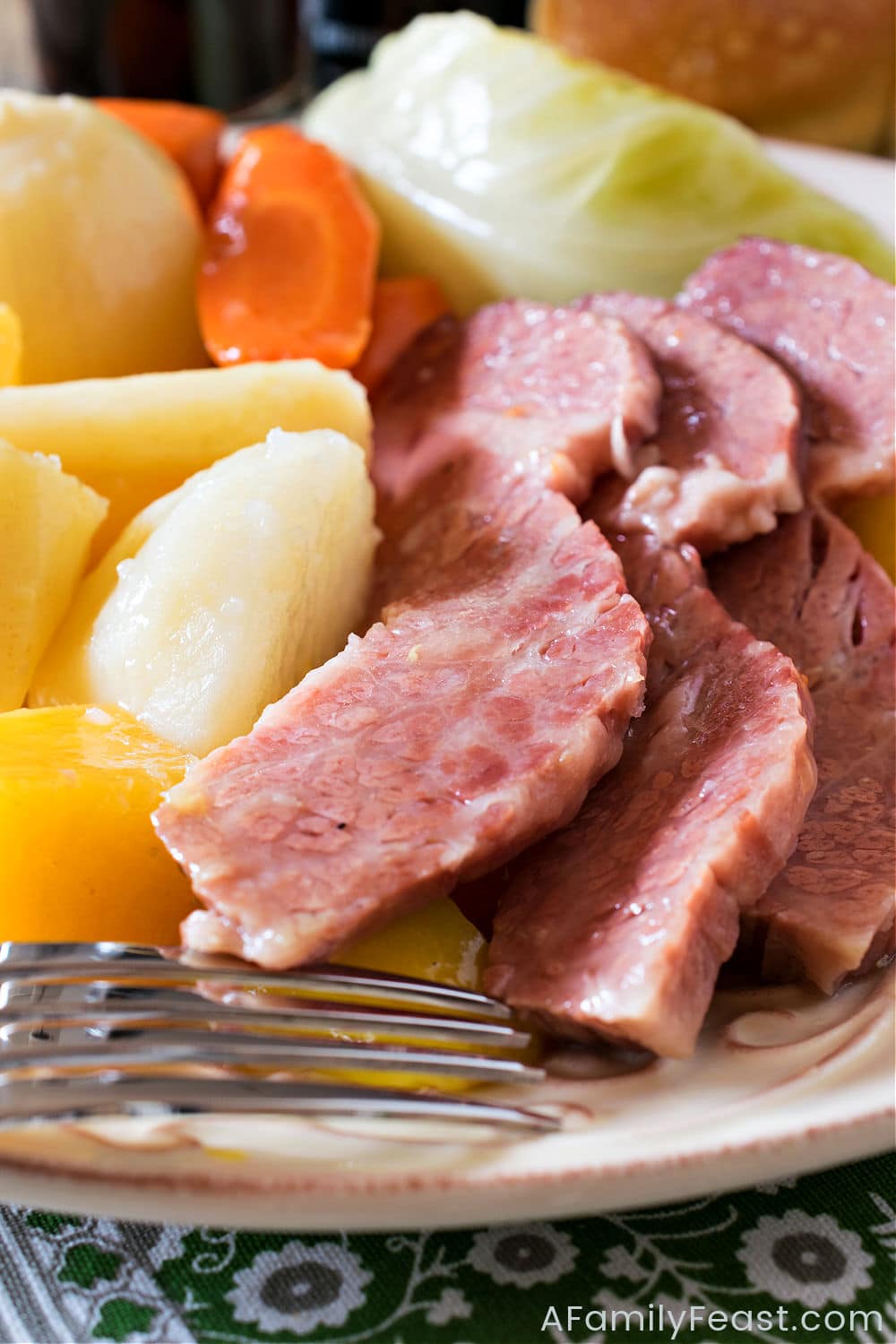
How do I make a New England Boiled Dinner?
- Place the corned beef in a large pot filled with water. Bring to a boil and skim off any foam that floats to the top.
- Simmer the corned beef for three hours – adding more water as needed to keep the meat covered as it simmers.
- Remove the corned beef from the cooking liquid and cool – see below about pressing the corned beef as it cools. Keep the cooking liquid in the pot.
- Gather the spices in a pouch made from a double layer of cheesecloth tied with butchers twine.
- Place the spice pouch in the reserved cooking liquid. Cook each vegetable until tender.
- Add the corn starch to a quart of the cooking liquid. Heat until thickened to a light syrupy consistency to create a sauce.
- Slice the corned beef into thick slices against the grain. Place on a platter with cooked vegetables. Spoon the sauce over the beef and vegetables, then serve.
Should I press the corned beef after cooking?
If you prepare your New England Boiled Dinner a day in advance, you have the option of serving the beef pressed or unpressed. Pressing the corned beef must be done while the meat is still hot.
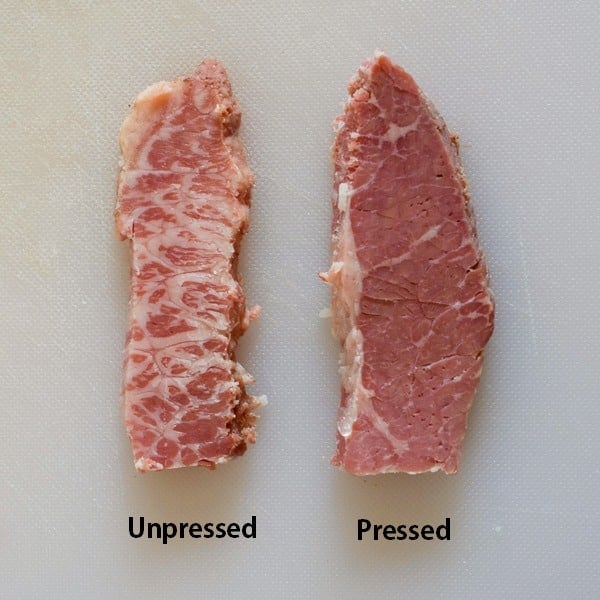
When the corned beef is pressed, any grains of heavy fat intermingled throughout the meat would be squeezed out yielding a less fatty looking slice.
This step is not totally necessary, but we wanted to show the difference. Once the meat is hot, you really can’t see the fat and as a bonus, fat tastes good. So this is your choice here.
Frequently Asked Questions
How do I make this recipe with smoked shoulder? First bring the meat to a boil in a pot of water, then pour out the salty liquid. Add more water, then bring to a second boil before you simmer it – following the rest of the recipe as written.
Can I make this in a slow cooker? Technically, you can. But we think boiling is the best method to achieve the best texture.
Do I make a New England Boiled Dinner with the flat or point cut of a brisket? We used the point cut as it is fattier and more flavorful, but you can use the flat cuts as well. The flats are not as fatty so pressing the meat as it cools is not needed.
This recipe originally appeared on A Family Feast in March 2016.
You may like these other Irish-inspired recipes:
- Boozy Guinness Cupcakes
- Beef and Guinness Casserole with Noodles
- Colcannon
- Irish Chocolate Pudding Shots
- Guinness Barbecue Sauce
We love seeing what you made! Tag us on Instagram at @afamilyfeast or hashtag #afamilyfeast so we can see your creations!
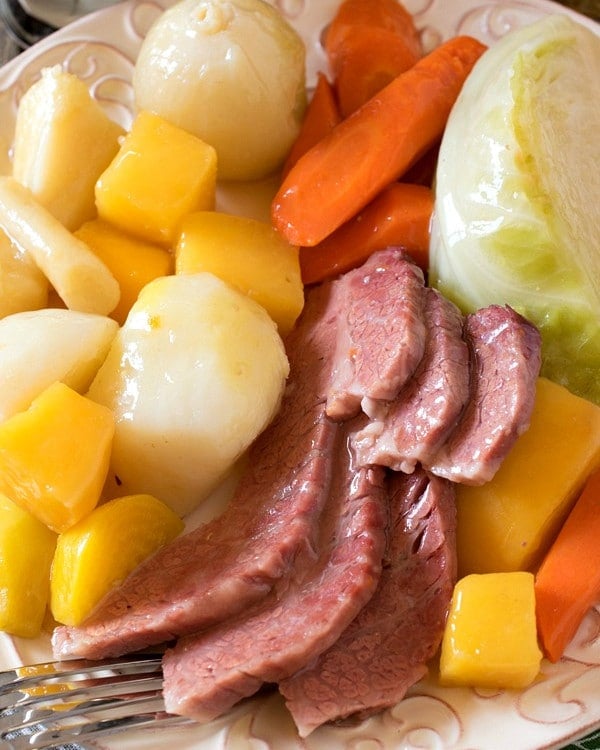
New England Boiled Dinner (Corned Beef and Cabbage)
Learn all of our tips and tricks to make the perfect New England Boiled Dinner. You’ll never have to worry about tough, over-cooked meat and mushy vegetables ever again!
Ingredients
- 4 1/2 pounds raw corned beef, we used point cut (Note: Once cooked, only about a third of that weight will be usable so plan accordingly and buy more if feeding a crowd. Two thirds gets lost in cooking and trimming.)
Spice bag mix
- 10 peppercorns
- 3 whole cloves
- 2 bay leaves
- 1/2 teaspoon whole mustard seeds
- 1/2 teaspoon whole coriander seeds
- 1/4 teaspoon whole allspice berries
- 1/2 inch square piece of whole fresh ginger
- 1 small cinnamon stick
- 1/4 teaspoon red pepper flakes
- (Alternately you can omit the spices and use a commercial pickling spice mix)
Vegetables
- 3 pounds green cabbage
- 2 pounds new red potatoes
- 2 pounds carrots
- 2 pounds whole small onions (8 onions weighing 4 ounces each)
- 1 pound yellow or white turnip
- 1 pound parsnips
- 1 pound yellow beets
Other Ingredients You Will Need
- 2 tablespoons corn starch
Instructions
- Place corned beef and any liquid from the bag into an 8 quart pot and fill with cold water. Bring to a boil and skim off foam that floats to the top. Reduce to a medium simmer and cook uncovered for three hours, replacing hot water every 30 minutes or so to keep water to the top. After three hours, let sit in water off burner for 15 minutes then remove to a sheet tray. The spice bag mix does not get used while the corned beef is cooking. Corned beef has enough flavor on its own and you want the taste of the meat to shine.
- OK, here is trick number one. In food service, we would cook the corned beef the day prior, place in the cooler with a heavy weight on top and the next day, any grains of heavy fat intermingled throughout the meat would be squeezed out yielding a less fatty looking slice. To do this at home and to show the difference, I cut the cooked roast in half and left one unpressed and pressed the other by putting a second sheet pan over the top and topping with a heavy Dutch oven filled with some water. That whole setup is then placed in the refrigerator overnight. This step is not totally necessary but I wanted to show the difference. Once the meat is hot, you really can’t see the fat and as a bonus, fat tastes good. So this is your choice here – see photo in post above for reference.
- There should be about 6 quarts of liquid left in the pot and this will be flavored now with the spice bag.
- Lay out a double layer of cheese cloth and fill with peppercorns, cloves, bay leaves, mustard seeds, coriander seeds, all spice berries, fresh ginger, cinnamon stick and pepper flakes. Pull up sides and tie with butchers twine. (Alternately, you can just use a commercial pickling spice mix).
- Bring the pot back to a boil and place the spice bag into the pot. Boil for ten minutes, then remove and discard the spice bag. It has served its purpose.
- To avoid overcooked vegetables, we took the time and effort here to cook each vegetable separately so that I could give you the exact time that each vegetable takes to be perfectly cooked but not over cooked. If you don’t want to do that, below we list each vegetable with how to prepare and the exact time to cook.
- Bring the 8 quart pot with the now flavored liquid to a boil to start cooking the vegetables. Based on the timing below, you can place vegetables in the order of the length of time they take to cook, ending with the vegetable that takes the least time to cook. Each is listed below.
- Cabbage: Cut the end off the cabbage but do not core. We leave the core attached so that the cooked cabbage stays in wedges without falling apart. Remove any discolored outer leaves and cut the cabbage in half through the center of the core. Then cut each half in half keeping the core intact for each piece. Finally cut each quarter in half again keeping core attached to each wedge. Place in boiling liquid. The liquid will take about eight minutes to come back to a boil and only about four or five additional minutes to cook.
- Potatoes: Peel the potatoes and cut in quarters if large or thirds or halves if small. Place in boiling liquid. The liquid will take two minutes to come back to a boil and 15 minutes to cook.
- Onions: Cut top and bottom off and peel but leave whole. If you cut them, they fall apart and are hard to fish out after. Place in boiling liquid and cook for 25 minutes including the time it takes to come back to a boil.
- Parsnips: Cut off ends and cut on the bias into uniform sized pieces. They should be large enough to be more than a mouthful but not left whole. Place in boiling liquid and cook about 8 minutes including time to come back to a boil.
- Turnip: Cut off both ends and peel completely down to white or yellow meat. Make sure all skin and green inner lining is peeled off. Cut into 2-3 inch chunks and place into boiling liquid. Cook for 15-18 minutes including time to come back to a boil.
- Yellow or orange beets (not red): Peel and quarter. Place in boiling water and cook for 15 minutes including time to come back to a boil.
- Carrots: Peel, cut ends off and cut into similar size and shape as parsnips. Place in boiling water and cook for ten minutes including time for liquid to come back to a boil.
- If cooking all vegetables in the same pot, the order would be as follows: onions, potatoes, turnip, beets, cabbage, carrots and parsnips, letting each cook for a bit before adding the next. (I prefer cooking each separately, but only because I am very finicky about over cooked vegetables and I like serving them separate to give dinner guests or family the chance to select what they want.)
- At this point, you can refrigerate everything including the rest of the liquid and get back at it just before dinner that day or the next day. There should be two quarts of liquid left. If you have less, just add enough water to bring it back to two quarts.
- About an hour before dinner is to be served, place each cooked vegetable in a large roasting pan or similar type of vessel.
- Heat the 2 quarts of liquid and pour half over the vegetables. Cover the top of the roasting pan with a lid, an inverted sheet pan or foil and place over two burners. Bring the heat to a medium flame with both burners and gently heat the vegetables back up. This will take 15-20 minutes to heat them through. Keep covered so no moisture escapes.
- Here is another great tip. By now you were probably wondering what the corn starch was for. Basically we are going to make a glaze to heat the meat and serve over the vegetables as they are served. The glaze gives everything a nice tasty glisten and is great to sop up with bread.
- Mix the corn starch with a few drops of water to form a slurry and add it the remaining quart of hot stock. Heat and stir until thickened to a light syrupy consistency.
- Place the cold corned beef on your cutting board and remove any visible fat. Slice in thick slices against the grain.
- Place a large skillet, fry pan or cast iron skillet over a burner and add in sliced corned beef along with half the thickened liquid and turn on the burner. Cover and heat over medium until just hot.
- Finally to serve (bet you thought we would never get there), place hot meat and vegetables on each dinner plate and spoon a little of the remaining hot thickened liquid over each. If serving family style, transfer meat and vegetables to a platter and spoon or brush the tops with the glaze.
- Serve with nice crusty bread or a hearty rye. By the way, this meal lends itself to great leftovers.
Last Step! Please leave a review and rating letting us know how you liked this recipe! This helps our business thrive & continue providing free recipes.
Notes
This recipe can be prepared and served all on the same day, but for the best presentation, taste and texture, prepare the day before and heat through when ready to eat.
If cooking the vegetables together and not separately, follow these steps.
One liquid is boiling, add onions and once boiling, time seven minutes once boiling. After seven minutes add potatoes and turnip. Once boiling, time three minutes and add beets. Once boiling, time two minutes and add cabbage. Once boiling, time three minutes and add carrots. Once boiling, time two minutes and add parsnips. Once boiling, time eight minutes and you are done.
Honestly, it’s easier to cook each vegetable separately, but if you want everything all in, following these steps will get everything done at the same time.
If you will not be cooking one or two of these vegetables, just adjust timing as needed.
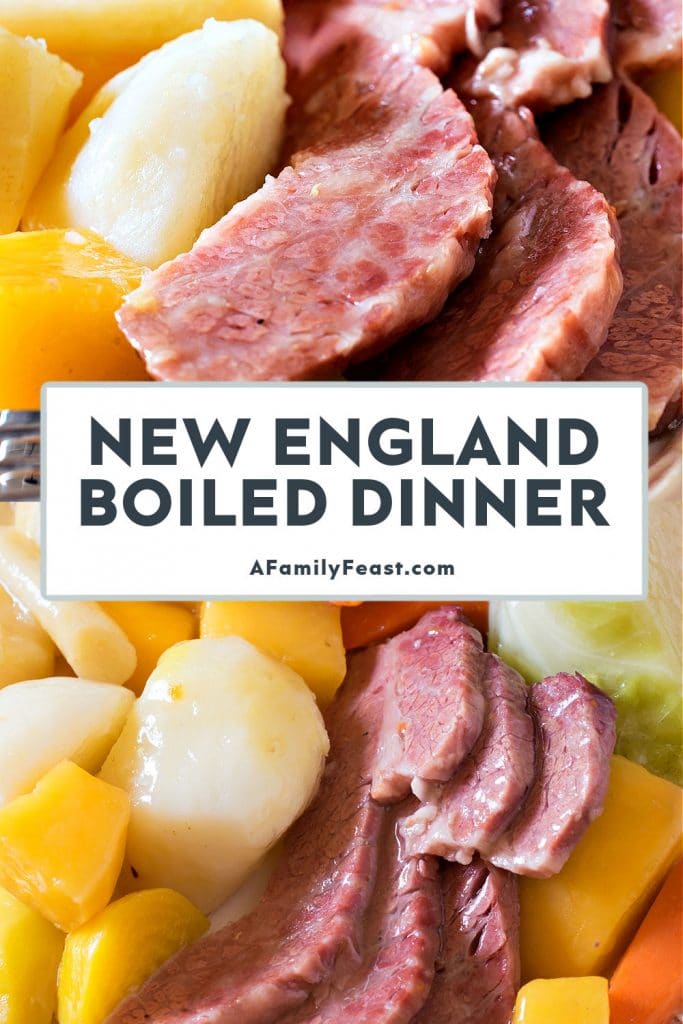
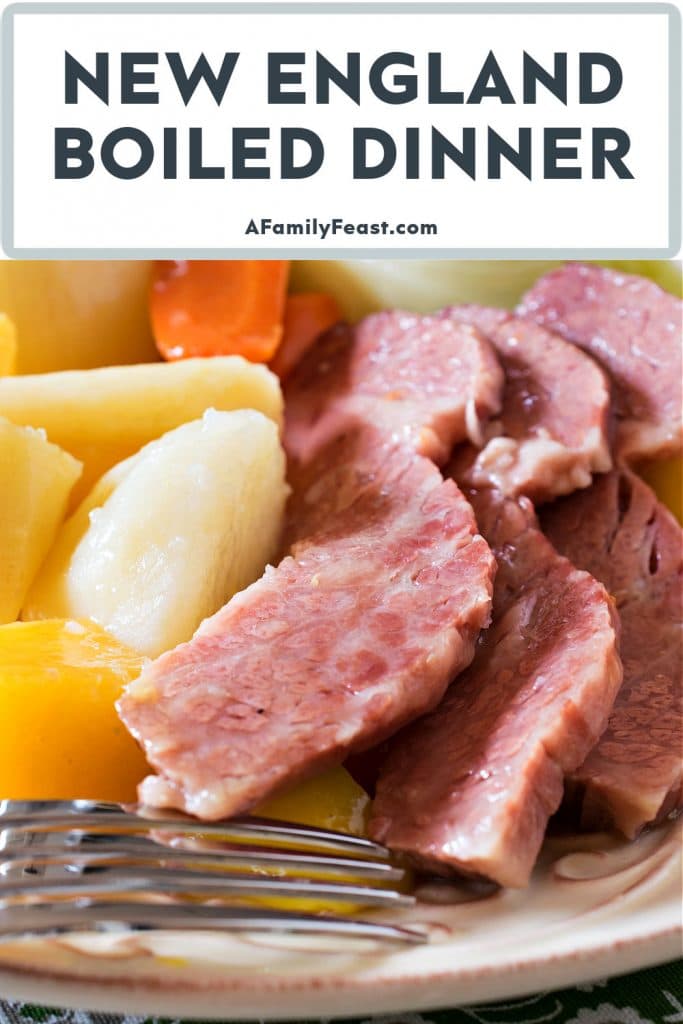
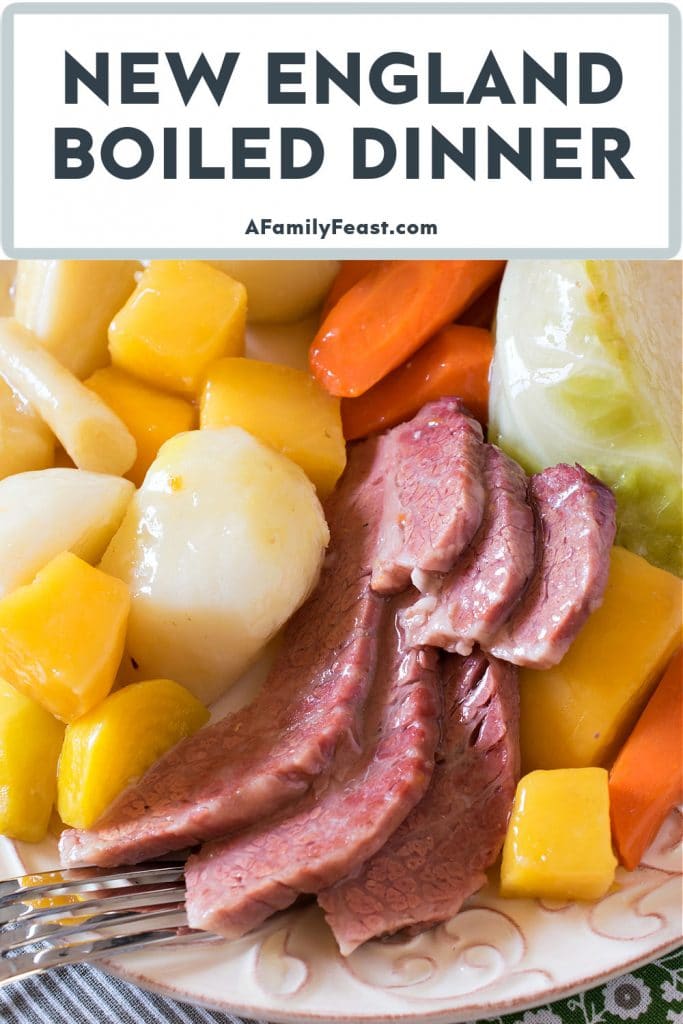

I am totally confused about the order of adding the vegetables to be boiled and for how long.
In order:
onion 4 min then add
potatoes 15 min then add
turnips 17 min then add
beets 15 min then add
cabbage 13 min then add
carrots for 10 min then add
parsnips for 10 min. Total 85 min. ?????
and what if I want to drop the beets?
Hi Bruce. I guess that does sound confusing. Give me a few minutes to go in and edit the recipe to try and make it clearer.
OK Bruce, I just added a section in the NOTES field of the recipe spelling out the timing. I also mention what to do if you eliminate one of these vegetables.
You may need to clear your cache for the update to show on your device or PC.
Hope this helps,
Jack
I just want to say I followed this recipe to a T and it was a massive hit. I prepared this meal for several men who hail from Newfoundland as they were homesick for “salt meat” dinner. I made this for them instead and spent the better part of the day making pease pudding to go along with the meal. One guy I thought was gonna cry. Said it was the best meal he’s had in years. So…thank you. This is now my “go to” recipe for corned beef.
Oh wow – Thank YOU Jude for letting us know! I’m so glad the recipe was such a hit!
I read lots of recipes to try and improve on making a boiled dinner. I read through your recipe several times and decided to try it tonight. We had friends over for dinner and everyone commented that it was the absolute best boiled dinner they have ever had. My husband and I feel the exact same way. It was so delicious. Now I think it is my new favorite dinner!!! My husband asked if I could make it again next week!!! Thank you so much for taking the time to explain all the steps to make this dinner a success. Your method is the only way I will use from now on. Thank you again so very much!!!
You’re very welcome Linda – so glad the recipe was a hit!
I must say, I’m born and raised in New England, lived here all my life and never seen a fussy recipe like this. I grew up with Dutch cooked Corned Beef and Cabbage long simmered on the wood range. Since then I’ve eaten and cooked innumerable boiled dinners at home or in restaurants and food service. I do like your spices used in this dish, and the unique addition of beets. The only vegetable I cannot abide overcooked is cabbage. One change I’ve made is to prepare the dinner in my slow cooker, then add wedges of cabbage or Brussels sprouts on the top for the last hour. Comes out perfectly tender, not slimy! My Mother taught me to spike 4-5 whole cloves in a chunk of onion and add 3-4 or more tablespoons of Apple Cider to the Broth, this balances the saltiness. I myself add some garlic cloves and liquid smoke too. Using the same General recipe, my Mother would use a smoked pork shoulder, a picnic ham, or a Boston Butt to create another type of Boiled Dinner. She also cooked Pot Roasts in a Dutch Oven, on the wood range, but used seasonings that blend with beef. So a Pot Roast can also be a “ Boiled dinner”. This was a very interesting read. I’m going to save the recipe for inspiration at least. Especially the seasonings and the beets. Way better than Rutabegas in my book. I like white turnips and parsnips, but can’t stand boiled rutabegas. BTW I’ve lived in the Boston area for over 45 years. NH before that.
Hi MaryAnn
I grew up in Brockton in the 50s through the 70s and have lived in several MA towns in my life from Gloucester to Dorchester and now settled in Plymouth. I also lived in NH for a few years where I ran a company in Somersworth. My dad is Italian and my mother French Canadian so my experience with boiled dinner is just being in the industry, and not from family tradition. I know what I know with this dish based on commercial kitchen experience, not family tradition. Yellow turnip, sometimes called rutabagas, are an acquired taste I admit, which is why I also include white turnip as an alternative.
Honestly, there are hundreds of traditional recipes that are region specific and that many more which have been interpreted differently over the years based on availability of product and individual tastes. So I can’t say proof positive that my recipe is the best, since there are many variables of the dish, it simply is one option of many available.
Good luck MaryAnn
Jack
P.S., My mother made a dish with smoked shoulder, onions, escarole and corn bread stuffing. I can’t remember the French name for it, but it was delicious and yet another variation of a boiled dinner.
Hi MaryAnn,
I had to smile when I read your comment. I’m from Wisconsin and we make dishes similar to this using ham variations as well as beef roasts. All the while as I was reading the original recipe (with a watering mouth as these are my absolute favorite meals) I kept thinking it would be perfect if those flavorless parsnips were tossed out and a flavorful rutabaga was added. I’ve never heard of them referred to as yellow turnips. 🙂
Born on St Patrick’s Day in Boston and now approaching my 70’s, I have had many a New England Boiled dinner with families and friends but your recipe and such detailed instructions was so inspiring for me to try it your way.
Almost…I added chopped celery.
Due to the pandemic St Pats Day was right around the corner when our Country went into lock down so we cancelled the traditional dinner at our house and froze the 10 lbs of Corned Beef we purchased at Costco. Today being Father’s Day my sons recommended I make it again and everyone was so impressed with the way in turned out all of us, but one, actually tipped the plate and licked up the juices like we did as children and my wife of many years said that was the best Corned Beef and Cabbage dinner that I have ever made! Thank you for sharing your fabulous recipe. I’m not going to wait a whole year before making this dish again.
Wow Jack! Thank you so much! I’m so glad the recipe was a success! Happy Father’s Day!
I love this dinner the way you have it. My girlfriend uses the shank. Its also good.
Thanks Judy!
I’ve always loved corned beef, having lovely childhood memories of soft salty red meat served with cabbage, mash and white sauce. I pop mine into a crockpot in the morning before going to work with some peppercorns, onion and carrot and a bay leaf. By the time I get to dinner time, this meat is delicious and ready to eat. Do you use a crockpot?
Hi Alison – No we don’t use a crockpot!
You said the 4 1/2# corned beef ended up being 1 1/2# after pressing. The recipe states it serves 8-10. Is this correct?
Hi Cindi – Yes – it’s correct. The recipe makes quite a lot of vegetables so assuming you load your plate up with each of the vegetables plus a reasonable portion of the corned beef it will serve at least 8. If you are concerned about having enough corned beef, definitely cook up some more. Hope you enjoy the recipe!
Dear Jack,
Thank you very very much!
Feel free to come and cook for me anytime! 😉
I appreciated the step by step instructions (and your comments). I have made this before, but usually everything was in one pot.
After my stroke, my uncle volunteered to make me Corned Beef and Cabbage; neither of us realizing it would be months before I would be able to eat ‘real food’, instead of pureed food. I wish he was still around for me to give him this recipe. Thank you for reminding me of this.
Thank you very very much again.
Hi Jeannette – You’re very welcome – I’d be happy to loan Jack out to cook for you! 😉 We hope our recipe is just as good at your uncle’s version! And – I’m glad you are able to enjoy a home cooked meal of ‘real food’ again! Take care, Martha
Jack and Martha,
I bought a LOT of flats last Spring after St. Pat’s at my local Shaw’s. Marked down to almost nothing, it was hard to pass up. We ate quite a few boiled dinners last year in the polar vortex.. it kept the house warm and our stomachs quite warm!
I’m wondering, what are your thoughts on using the flat instead of the point for the brisket? Not as much fat to render, so I don’t think I would benefit from the overnight press. I suspect that it might adversely affect the broth, not having that fat to cook out and flavor it.
Hi Sam – You can certainly make this recipe with all of those flats you bought and you are correct – they are less fatty so you won’t need to do the overnight press. Having said all of this – the fat adds great flavor so it’s a trade off – the point end is fattier and perhaps more flavorful but the flats will still be delicious! Enjoy!